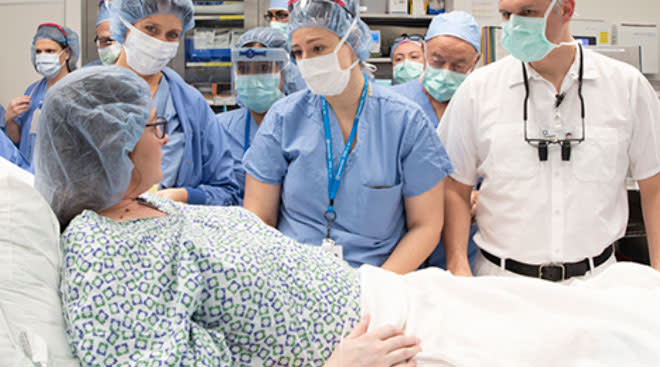What Is Secondary Infertility?
If you’ve gotten pregnant in the past without issue, it’s normal to assume you’ll be able to do it again once you’re ready. But the unfortunate truth is that there are no guarantees. While many couples will have a subsequent baby with minimal effort, others may encounter secondary infertility. This means that they’re having trouble conceiving again after an otherwise healthy pregnancy. It can be a punch in the gut for those eager to grow their families, but it’s not hopeless. If you’re struggling with secondary infertility, know that you have options. Here’s what to know about causes and treatments—plus tips for coping with secondary infertility.
You previously got pregnant and had a healthy and successful pregnancy, so you probably thought it’d be smooth sailing when you started actively trying again. But time, age and other factors can make it more difficult to conceive on your second (or third, fourth, etc.) go around. Secondary infertility refers to a person who has had a normal pregnancy in the past, but experiences an inability to get pregnant with a subsequent child, says Shaun Williams, MD, an ob-gyn and fertility specialist at Illume Fertility in Norwalk, Connecticut.
According to the US Centers for Disease Control and Prevention (CDC), infertility is less common among women who’ve had one or more prior births. So what are the secondary fertility statistics? According to the National Survey of Family Growth, about 6 percent of women 15 to 49, who have previously gotten pregnant and delivered are unable to get pregnant after one year of trying, and 14 percent have difficulty getting pregnant or carrying to term.
While secondary infertility occurs less often than primary infertility, it’s important to note that the former occurs more frequently as the age of the egg progresses. As women get older, natural changes in your egg quality can make it more difficult for them to conceive. According to Williams, at age 25, around one in seven couples will experience infertility. But between ages 35 to 39, as many as one in two couples may face these challenges. In other words, if you’re trying to conceive a second or third child at a later age, the likelihood of experiencing secondary infertility is higher.
It’s frustrating to experience hurdles on the journey to expanding your family—and you probably have a lot of questions about why this is happening. “The same issues that cause primary infertility can cause secondary infertility,” says Lora Shahine, MD, a reproductive endocrinologist at Pacific NW Fertility in Seattle and host of the Baby or Bust podcast. “Just because someone was able to conceive easily in the past, it doesn’t mean that reproductive health is the same in the present,” she explains. That said, these are among the more common reasons you may have trouble conceiving after a normal pregnancy:
- Decreased egg quality or diminished ovarian reserve (DOR). A woman’s fertility declines with age. It’s a normal part of reproduction to experience difficulties as the age of the egg of the woman trying to conceive increases, says Williams.
- Reproductive and general health issues. Williams says that a woman facing certain abnormalities, such as endometriosis, uterine fibroids and other general health issues may be more likely to experience secondary infertility.
- Male fertility. A man’s sperm count and quality change with age, but these factors typically have a minimal impact on his fertility rate, says Williams. Of course, other general health concerns, such as diabetes, hypertension and obesity, may cause a decline in a man’s fertility potential over time, he adds.
You may have gotten lucky and conceived on your first or second try last time, but don’t expect that to be the norm. Typically, doctors recommend seeing a specialist if you’re under 35 and have been trying to conceive without success for 12 months or longer; or if you’re 35 and over and have been trying unsuccessfully for more than six months, advises Williams. Of course, if you have concerns about secondary infertility, don’t hesitate to reach out to your ob-gyn or a reproductive endocrinologist before you reach those benchmarks. What’s more, Shahine adds that if you or your partner have had significant changes to your health since previously conceiving, a trip to the doctor’s office may be warranted sooner rather than later.
If you’re ready to seek out reproductive assistance, you’re probably wondering about secondary infertility treatment options. In short, they’re very similar to those available to couples experiencing primary infertility. “If there’s an identifiable cause, treatment is geared towards that specific fertility issue,” says Williams.
For starters, your doctor will address any underlying issues that could be contributing to secondary infertility, such as thyroid disease or fibroids in the uterus, says Shahine. She notes that if irregular ovulation is the culprit, a low-tech intervention, like ovulation induction with medication, may help; for borderline sperm count, intrauterine insemination (IUI) is a viable plan. In vitro fertilization (IVF) is the most high-tech and expensive option, but it treats issues IUI can’t—such as blocked fallopian tubes and a very low-sperm count—with the highest rates of success, she says. Williams adds that, if an anatomical problem has developed since a prior pregnancy, surgery may be necessary in certain instances.
The reality is that infertility associated with advancing maternal age can be more difficult to overcome. But treatments geared toward improving ovarian function and egg production can increase the odds of conception. “Many couples demonstrate ‘unexplained infertility’ if no identifiable problems are seen during an initial evaluation,” says Williams. “Even in these situations, however, treatment options are available that can increase the likelihood of a successful pregnancy.”
Some more encouraging news? “For couples who have had a prior pregnancy and are experiencing secondary infertility, there’s a higher likelihood that pregnancy will occur again with fertility treatments,” says Williams.
Secondary infertility can be frustrating, stressful and confusing for those that conceived with minimal effort the first time around. “Seeking evaluation early can relieve some stress,” says Shahine. Nevertheless, dealing with the physical and emotional aspects of this struggle can take a toll. Here are tips for coping with secondary infertility:
- Acknowledge your feelings and seek help. Even though you may already be a parent, the experience of struggling to conceive a subsequent baby is difficult on your body and mind. “Emotional wellness and mental health are key—finding therapy, support and mindfulness can help along the way,” says Shahine.
- Connect with others. Williams suggests joining a fertility support group, so you have a safe place to express your feelings and find solidarity. You can also reach out to a therapist or counselor who is specifically trained to help those facing infertility.
- Practice self-care. Williams emphasizes the importance of taking care of your body, mind and soul. Eat well, get regular exercise and find other tools to decrease stress (acupuncture, massage, etc.)
- Don’t wait too long. You have to be a proactive advocate for yourself and your family. “The biggest mistake I see in my own practice with patients with secondary infertility is waiting too long to get an evaluation,” says Shahine. “For couples that conceive easily the first time, the assumption is that it’ll happen ’next month,’ but we [may] find an issue we can address and patients often say they wish they’d come to see me sooner.”
About the experts:
Lora Shahine, MD, is an ob-gyn and reproductive endocrinologist at Pacific NW Fertility in Seattle and the host of the Baby or Bust podcast. She earned her medical degree from Wake Forest University School of Medicine in Winston-Salem, North Carolina.
Shaun Williams, MD, is an ob-gyn, reproductive endocrinologist and fertility specialist. He is a partner at Illume Fertility, a practice in Norwalk, Connecticut. He received his medical degree from Baylor College of Medicine in Houston, Texas.
Please note: The Bump and the materials and information it contains are not intended to, and do not constitute, medical or other health advice or diagnosis and should not be used as such. You should always consult with a qualified physician or health professional about your specific circumstances.
Plus, more from The Bump:
Navigate forward to interact with the calendar and select a date. Press the question mark key to get the keyboard shortcuts for changing dates.



















































